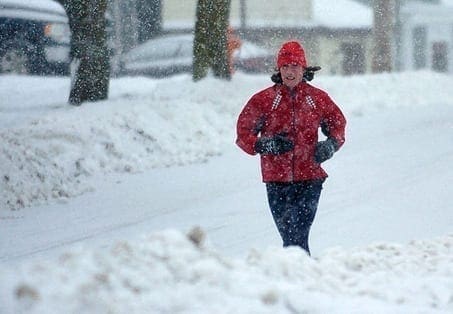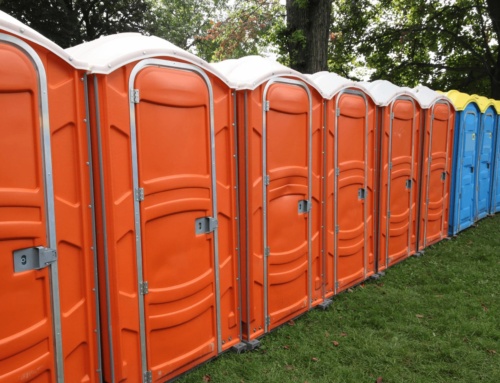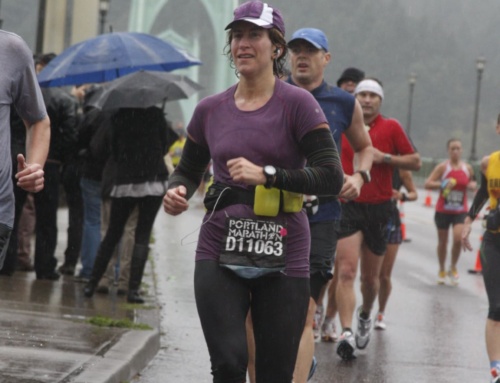
Oh, we know this well: This photo was taken near where Dimity and I first ran in the snow (alas, not together)
If you’ve read Run Like a Mother, you know that Dimity and I were both introduced to running as a cross-training tool while rowers at Colgate University. The school is in central New York where, during the winter, it snows like it rains here in Portland: every.single.day. Some of my most vivid memories from the collegiate era of my life is of running head-on into driving snow, past open fields that let the wind whip unabated for miles. Somewhere there’s a photo of me pre-run, outfitted in red, wool union suit with gym shorts over that and a hooded sweatshirt (cotton!! Quelle horreur!) on top piled over a tee or two (again, cotton). I shudder at the thought.
Yet, 25+ years later, I’m proud I didn’t let the weather stop me from running. And this weekend on our Facebook page, a lot of mother runners testified to the same: Tami ran a 16-mile race when it hit a “high” of 20 degrees; Tammy did 16-mile training run, solo, in Wisconsin sleet. (Makes me wonder if “Tami/Tammy” means “badass mother runner undeterred by crappy weather” in some language.)
Still, some moms were asking what to wear, like Nicole, who fretted that it was 9 degrees and her winter gear is only rated to about 20 degrees. So I figured it was time for a primer on running in craptastic weather, whether it’s frigid, snowy, or wet.
-Dress like it’s 10 degrees warmer than it really is. Maybe it’s just me and my hot blood, but I despise overheating while I exercise. You should feel chilly, if not almost cold, when you step outside. On my 18-miler this past weekend, my forearms were cold for the first few miles, but I never regretted my choice of a vest instead of a jacket.
-Have escape hatches built in, like a zip neck on your shirt, sleeves that can easily be rolled up, mittens that convert to gloves, arm warmers that can be pushed down or pulled up. My favorite? A Sugoi jacket that converts to a vest. One of the single most versatile garments I own.
-Wear a wicking first layer–and that includes socks and undies (if we haven’t convinced you to go commando yet). Having a sweaty garment stuck to your body, trapped underneath other layers, is a sure-fire ticket to getting chilled and being miserable. Wear a synthetic fabric that’ll pull sweat off your hard-working body and move it toward the outer world.
-If you need an insulation layer, fleece, down, synthetic fill, and wool all make smart choices.
-Go lightweight on your outer layer, unless you favor the terrarium effect. Go for a jacket with lots of zippers and mesh inserts—escape hatches for built-up heat and moisture. I say forego a hood—too much flap-flap-flap when not in use—and opt for a hat instead.
-Get wooly. No, not suggesting you let your leg hairs grow long enough for insulation. Instead, invest in a wool running top. It’s true what they say about this natural fiber: It keeps you cool when it’s hot, and warm when it’s cold. And it retains heat when it gets wet, as I was reminded when it started raining around Mile 10 of the weekend’s run. Wool socks are a must-have for running outdoors in frigid weather—Dimity loves Balega ones.
-Remember accessories: A fleece beanie really can make the difference being comfortable and miserable. A brimmed running hat is my BRF on rainy days. And lightweight running gloves keep my mitts warm, and then can be stashed in my waistband or held if I get too hot. In colder temps, consider a balaclava to keep your neck toasty and warm the air before you suck it in.
Now your turn to share: What’s your go-to gear in cold or wet weather?







This just reminded me of how UNprepared I am for our move back to the states! Living here (in Okinawa) for 3 years in a subtropical climate really does a number on what your mind thinks sounds cold and what you body actually knows is cold! I think I’ll need to do some shopping for winter running after we get back!
Fleece beanie, definitely vest, good gloves and never to be forgotten road id wristband, for when they find my cold dead arse in an ice crusted snow bank, frozen beyond recognition. (A girl’s gotta be prepared!)
Fleece lined tights. I have a super lightweight pair and the heavier pair. Living in Chicago, we run outdoors in all conditions and are prepared for everything from tundra like cold to tropic like heat/humidity. Thus past weekend ny running girls and I ran a 10k in the snow. The temp at the start was 17. it was a blast!
I love running in the cold! It makes me feel alive! Anyhow I would say my go to when it’s super cold is the balaclava. I can pull it up to warm up my cheeks and breath, then I can push it down to keep my neck warm. It really does make a huge difference. I was wondering if anyone has run with a down running coat? Lulumon came out with a new one and wondering if it gets to warm. Just curious!
I always use the What to Wear option on Runners World (actually made it a shortcut on my phone.) It’s a good starting point to figure out what I need to wear.
Generally: tech base layer, fleece jacket/hoodie, tights, Smartwool hat and neck gator, sometimes gloves, but my jackets have mittens built in & that’s usually enough. If its really windy I would add a windbreaker and/or wind pants.
Socks are always the same, feet sweat too much to use warmer ones.
Smart wool socks and a “3 bears” wardrobe of tights choices – light, medium and heavy. Currently in love with Mizuno Breathe Thermo and Asics Thermopolis.
My favorite cold weather gear is a treadmill. I am a wimp!
Seriously, though, I don’t mind cold so much as much as wind and ice that stops me. When I do suck it up and run in the cold, I actually find myself liking it.
Brooks windbreaker- I love it!
My BRF and I both invested in Loki Myth Soft Shell Jackets a few years ago for our after-the-kids-go-to-bed-it’s-crazy-cold-and-snowing runs. It has all kinds of convertible goodies; gator, mittens, heat vents. Love it.
My super awesome new Nike running tights! Love them! I also want to put in a plug for Darn Tough socks. Made in Vermont and they come with a lifetime guarantee. YOUR lifetime, not the life of the socks. Yes, they really mean it. Finally, what about shoes? I am just back from a brutal run in 6 inches of icy slush. All of me was fine except my poor frozen feet. The wool socks are just not cutting it, but do goretex shoes or whatever really work?
Heard a tip that I haven’t had a chance to try yet (we’ve had a dry winter here) but it was to put duck tape on the front of your tennis shoes, where the holes are. Sounded good to me.
I have that same jacket in the photo and LOVE it, not just for its wind and water barrier quality….it stands out against the snow, of which we had 190 inches last year. Although, by the end of snow season, I am ready to set fire to it. And, on a long run when the mercury is down there, I don’t fill my bottles with cold drinks. Even at room temp or warmer, it still has ice chips in it after a while. Actually, might be an inventive way to shake a margarita….
The Treadmill! I hate to get cold. I know that once I get going, I will warm up when I run outside. It seems that once my fingers and toes are cold, I am miserable and can NOT get them warmed up.
I have a pair of Smart Wool sport socks that I love!
I love wool for running winter or summer. Smartwool socks and an Ibex sweater (sometimes more than one) – warm even when wet. I have an ancient pair of Nike polartec tights and if it is colder (I live in ND) I put on a pair of Ibex pants over the top. Zippers that can be moved up when facing the wind and down when I have the wind at my back. I love running outside.
That said, last Saturday the wind chill was 35 degrees below zero. I was more than happy to hit the treadmill.
I love my Melanzana. It’s a company out of Leadville, CO. microfiber grid fabric–I have the tights and a hoodie ‘sweatshirt’ both are great for breathing and layering–putting stuff under or over as the case may be.
Mizuno breath right top.
Smartwool neck gaiter–I don’t have turtleneck exercise shirts, I have short hair and these are great tucked up on the head and then a hat over.
I have pearl izumi winter cycling tights (no pad) that I wear too.
If it’s below 30, I add my Nike winter running pants, which are basically a straight leg pant that just adds air insulation, suppose to have extra protection for butt and thighs to keep those areas from extra freezing.
Goretex…. Breathable, waterproof I have boots, athletic shoes, etc
Wool socks
Tights….again 3 bear styles
Breathable cami from maternity days
Sports bra
long sleeve tech shirt
cabelas wind river pull over
columbia gloves
goretex jacket
hat with cut out for ponytail
typical layering….for atypical weather
I also have a wool union suit….:) it is lightweight but oh so toasty…..not a great fashion concept but when snowshoerunning it is nice.
I am curious about these “3 bear tights”. I have never heard of them. Do they have a web site?
I get so hot — so mittens with gloves are a must have and I prefer ear warmer to hat since I get so hot (but on a really cold day, will keep that heat in with a fleece hat). I also layer running pants under a skirt so my thighs have a bit more heat, but my legs are not over warm. I use a tank (small or nonexistent boobs so tank is better than bra), LS top, and a fleece. If windy, I will wear my North Face jacket over the LS top. I can get through even a 5 degree run in this get up. And I LOVE my new wool socks, thanks SBS and Dimity for convincing me of the value of this winter staple.
I’m new to the outdoor winter running scene, so I was more interested in hearing what you recommended than in being able to share much of my own… I do love the TitleNine “Cold Killer” pants I got for Christmas though. They really are as great as they say… which is probably why they’re sold out so much of the time.
What I’d love to hear more about is dealing with ice… I’m terrified of falling and we have a ton of it here is snowy cold Montana…
Try some Yak Trax
Any specific kind? The thought of running on those seems kinda… clunky. Any experience with them?
I have this outfit prep down to a tee…Thank you Colorado winter. :)
Nike running tights (if it is super cold, I wear sweats over them), sweat wicking baselayer, thermal top, saucony fitted jacket, down vest. Sweat wicking Nike beanie with a brim for protection. Wool socks. Run on!! :)
As a lifelong midwesterner, I am sort of proud of running in temps as high as 100+ and well below zero during the course of a year.
For cold, I love Smartwool products on my feet and head, though a hat is too hot if it is 15+. I have a fleece Nike hat that I got at the Outlet for like $4 – with a ponytail hole even – great deal!
I also have general guidelines for myself :
Bottoms: below 30= running pants or tights instead of capris, below 10 they need to be thicker — I love the Moving Comfort NoChill pants. Sometimes a baselayer on bottom if it is below zero.
Tops: below 30 = Two light longsleeve layers, below 20 = light baselayer and thicker zip jacket — I LOVE the one I got at the Nike Women’s Marathon, though I have a North Face jacket that has a pocket on my chest that is really great, below 10= thicker baselayer and thicker jacket.
I think my go to is a fleece beanie with a pony-tail hole . . . that way my hat doesn’t move around too much on my run!
I use Buffs for everything, but when it’s really cold I have one around my neck that I can pull up over my hat in the back to keep my neck warm and up onto my chin in front. I can regulate a bit just by pulling it up and down.
Also love my Under Armor fleece lined tights – they aren’t too heavy, but they keep the wind from whipping right through you.
Smart wool socks are always good. If it’s cold and wet/snowy I opt for my Solomon XT Wings GTX trail shoes and yaktrax.
I dress by temp. I’m an over-heater-sweater-pitter-outer, so I know that if it’s 43 degrees, even though that sounds cold, I can’t wear gloves or a beanie. I’ll overheat. Today it was 41 and pouring, but I was doing some speedwork, so no coat for me. On trails anytime, but especially in cold, wet weather, my favorite item is Smartwool socks. I’ve run 26 miles in mud and rain in those babies with no blisters. Plus they are cozy, last long and very cute. Happy winter running everyone!
I found some amazing running gear at TJ Mxx last year. Layer 8 turtlenecks ROCK! One of those and a jacket and I am good to go.
I can’t believe I am going to write this but I actually MISS running in the snow!! We relocated to Florida this past November and it has been quite different. No more yak trax here…there is something quite peaceful about a winter white run in the morning. Miss my dear RP Annie, hope you are staying warm in MI!!
I have a jacked from New Balance that I love – 3/4 zip so I can unzip when I get warm. I also broke out my YakTrax for a snowy run last weekend.
I really need to invest in some different socks for winter running.
Hands down my go-to pieces are a Craft base layer to start, Brooks Utopia Thermal Hoodie and a vest. If there’s sleet, I go with the Brooks Nightlife Jacket – love it! And gotta have Nike tights and Smartwool socks!
my go to? running inside. LOL I don’t even own a pair of running pants (only 1 capri, 1 shorts), so I’m limited to running outside when it’s really frigid. It’s been unseasonably nice in KS this time of the year, so I’ve taken advantage. Unfortunately, I’ve been freezing since winter really decided to show up.
Before you say “you live in NC and it doesn’t get cold there”, I’ll tell you this winter you’re right, it hasn’t been that cold, but has been in the recent past years.
As one of my layers I wear a long sleeve Nike shirt with 1/2 zipper. That material has super wicking properties that only chemists could manage to manufacture. It doesn’t matter if it’s windy, or sprinkling, or just plan cold, it does the job.
The worst for me is when my hands get cold. I like mittens OVER gloves on the days where it’s windy and frigid at the same time.
Thanks for a shout out!!! I would rather fun in the cold wayyy more than the heat
I run hot, so I love cold weather running! If it’s in the 20s, I’m usually in a tank & jacket. Anything colder, and I’ll put on a thin longsleeve base layer under the jacket. Arm warmers are great for the in between temps for me.
Well, here in Savannah, Georgia I don’t really have to worry too much about snow and sleet (thank the Lord!!) so my biggest challenge is making sure to not overdress. Yesterday was 74 degrees so it was my trusty black running shorts (commando thank you very much) and a short sleeve tech tee. Tomorrow’s looking to be a little rainy, so I may throw a long sleeve dry tee under my short sleeves. As for my favorite go to item, I’d have to say it’s my R&R 1/2 mary visor… lightweight and fabulous… can’t live without it! :)
thank you! I’ll be running in sun valley this week. and coming from warm and sunny florida it will be a mighty change!
This winter I have become a Smartwool convert! It is magical. I did a 12-mile run in -2 degrees wearing a thermal base layer and a 3/4 zip Smartwool midweight top over it. I also wore a balaclava and stayed plenty warm. I’m a believer. Bring on the wool!!
Since getting my IceBreaker goods (THANK YOU SBS and Dimity!), I am a total convert to wool. I now run (in Portland) in wool capris or a wool running skirt EVERY TIME. I have a collection of wool running socks from SmartWool and IceBreaker. I have the Buff neck gaiter in wool. I just ordered a thin SmartWool beanie because it was starting to bug me that my fleece hat made my forehead sweat. I overheat easily and wool is the best breathable fabric I’ve tried. And NO STINK! IceBreaker even says not to wash the wool clothes after each wearing because the wool doesn’t need it. Even the socks, if allowed to air out on my indoor clothesline, can be worn over and over.
First SW Michigan has “interesting” winters. This year I was training in mid 40’s and 50’s at the end of December (made running the Disney Half Marathon, by the way my FIRST half marathon, rather nice as Florida was high 50’s low 60’s). But now we are in the single digits with wind chills. Last year it was long underwear and sweats (didn’t know about tech gear). This year I love my wool base layer, and wool socks, OH and my wind/rain pants, love them. However the driving snow does make me want to reach for the ski googles!
I live in the rainy NW. How do you keep your feet DRY and warm? My toes are always soaked and frozen. :(
I live in Seattle where we don’t have many cold days, but lots of wet days. As a newer runner, I’m wondering if you have any suggestions for a lightweight, breathable water resistant layer. I am tired of being soaked!
This is a side note, but can you tell me who owns the rights to that sheep picture? I want to use if for something and am trying to run down the source.
Thanks!